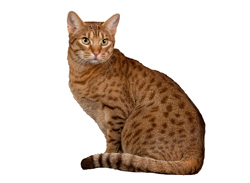Ocicats are selectively bred to resemble the stunning spotted cats of the wild. These medium to large, athletic cats come in 12 colors, including cinnamon, tawny, chocolate, lavender, blue, fawn, and 6 silver varieties, with bull's-eye spotted patterns. They are also occasionally ticked, pointed, tabby, or solid. On close inspection, individual hairs show bands of different color shades. Their short coats fit tight, accentuating their bones and muscular build, and their big, almond-shaped eyes come in all colors except blue.
Ocicats develop a fierce loyalty to their favorite humans. In return, though, they expect a tremendous amount of attention and play.
These cats are active, vocal, extroverted, and eager to interact. They do well in homes with children and other pets, as long as they get a good deal of attention. They possess a dog-like loyalty to the humans they bond with. Ocicats are relatively healthy and low-maintenance from a grooming standpoint, but they need more time and attention than a lot of other cat breeds.
The Ocicat breed was created to satisfy the common desire among cat lovers to have a wildcat. Physically, it's a great approximation, but the Ocicat has a fully domesticated temperament. It is descended not from wildcats, but from Abyssinians, Siamese, and American Shorthairs.
Ocicats develop a fierce loyalty to their favorite humans. In return, though, they expect a tremendous amount of attention and play. These cats have energy to burn, and they want company when they burn it. After, they'll head right for a lap for some petting and a nap.
This breed coexists well with children, cats, and dogs, but they don't appreciate taking a back seat to them. They prefer active households, provided they're the center of attention. They don't belong in homes where they'll be left alone often or for extended periods. They're outgoing enough to investigate strangers right away, readily dispelling the notion that all cats are unfriendly or standoffish.
The Ocicat is a smart, exploratory breed that will get into mischief when left to its own devices. These cats have a gift for getting into places they don't belong, including closed drawers and high shelves, and appropriate precautions should be taken to ensure their safety.
Ocicats are generally healthy and have a long lifespan that can exceed 15 years with proper care. A nutritionally balanced diet and plenty of exercise and attention help keep these cats healthy and well behaved. Veterinary wellness checks are recommended once or twice per year, and these cats should only be acquired from a breeder who offers proof of health screenings of kittens and their parents.
These cats have a genetic predisposition to developing renal or hepatic amyloidosis, conditions that cause an insoluble protein to accumulate in the liver or kidneys, causing lesions, organ dysfunction, and eventually organ failure.
Ocicats are also at increased risk for pyruvate kinase deficiency and hypertrophic cardiomyopathy. The former is a hereditary condition leaving the affected animal susceptible to anemia. The latter is the most common cause of cardiovascular disease in cats.
Ocicats are definitely trainable pets. Many owners teach them to walk on a harness or leash, which most individual cats are receptive to. They quickly learn their names and also respond to basic commands. Training and consistent enforcement of clear boundaries help manage the Ocicat's demanding nature.
Along with craving attention, these cats possess both brain and brawn, so they require a lot of mental and physical stimulation. Puzzle toys and motorized prey simulators should be provided, and it's important to interact with these cats on a regular basis. Ocicats enjoy learning new tricks and participating in games that allow them to climb and jump.
Ocicats can become possessive of toys and items they believe do or should belong to them. This can complicate things in a home with children or other animals, and it may extend to standard human items found around the house. Securing such items is often necessary, as repeated theft may occur.
The Ocicat's short and satiny coat is truly a low-maintenance coat. The frequent petting they seek out is usually enough to remove loose hair and keep the coat lustrous. One weekly brushing with a rubber curry brush, followed by a rubdown with a chamois, is also a good idea.
Ocicats shed little in general, but shedding may be heavier during the spring and fall. More frequent brushing helps. Bathing is unnecessary except in those instances when an Ocicat's fur is contaminated with a sticky or harmful substance.
Nails should be trimmed bi-weekly or more often, and the ears should be cleaned if they accumulate wax or become dirty. Monitor the Ocicat's ears for signs of infection, such as foul odor, discharge, or redness. Ocicats are prone to developing gingivitis, so dental care is important. Brushing their teeth regularly will remove tartar, and seeing a veterinarian for routine dental care will help prevent gum disease.
In 1964, Michigan-based breeder Virginia Daly crossed a ruddy Abyssinian male with a seal-point Siamese female in an effort to produce a Siamese with Aby-like points. The offspring looked like an Abyssinian, but it carried the gene for the Siamese pattern. Daly achieved her original goal by breeding one of these cats with a full Siamese.
A male named Tonga, the Ocicat prototype, also appeared in this litter as a serendipitous result. Tonga's parents also produced subsequent offspring with the same appearance. The breed's name, Ocicat, was coined by Daly's daughter, who noted the cat's resemblance to the wild ocelot.
Dr. Clyde Keeler, a geneticist, decided to pursue the breed after learning about Tonga. American Shorthairs were soon introduced into the gene pool, further developing the breed and adding silver colorations.
The Cat Fanciers' Association (CFA) began registering Ocicats in 1966, but didn't advance them to championship status until May of 1987. The International Cat Association (TICA) officially recognized the breed in 1986.

